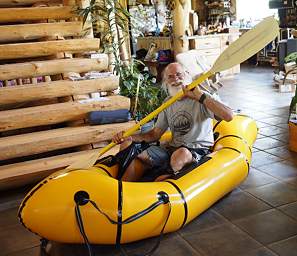
My friends Steve and Diana from Colorado invited me to float the North Fork of the Flathead River with them. I've never floated the whole thing and have always wanted to, so I said sure!
Now all I needed was a boat. My old fishing donut, a Watermaster, gave up the ghost last year. So now I needed to make a decision -- to buy another one, or get a super lightweight pack raft. I waffled back and forth between these two options all last year and never came to a decision. Now I had to make one.
I think the Watermaster is by far the best one-person fishing boat around, and it's really good on multi-day trips. There's ample room for hauling more than one drybag plus a daybag, plus a good way to store a rod case. I've done two weeks trips with two big Bills bags on it plus a day bag. In addition, you don't have to tie the boat up when you want to fish. You just stand up in the hole in the middle of the boat and the boat is captive around your legs. In addition, because it is rowed and not paddled, you can just drop the oars or stick them under your knees and have both hands free. A superb fishing boat.
On the other hand, it weighs a lot, about 30 pounds. That's too much for backpacking if you're doing anything other than a one day trip. There are a few wilderness trips I've wanted to do for some time but couldn't because I didn't have a boat I could easily pack in. In the end, I decided to buy a lightweight pack raft. I ended up with an Alpacka Gnarwahl. It's light — something like 7.5 pounds. It packs small — the size of a two-person backpacking tent. I got the version that's a self-bailer; it's lighter than the decked versions, and I didn't think I'd be using it like a regular decked kayak. That said, it's a lousy fishing boat. It's colder than a decked boat would be, because you're basically still sitting partially in the water. It would be terribly inconvenient to have a decked boat on a fishing trip; I've learned that in the past using my hard-shell kayak. You end up pretty much not fishing. If you're going to fish, you need to be able to get in and out of the boat easily.
 |
| The Gnarwahl |
Steve and Diana drove up from Colorado, and after an overnight at our place we threw my gear into their raft and headed north.; We spent the night in the San-Suz-Ed RV Park and Campground near Apgar in Glacier, as Apgar was full. The campground itself was fine, but it is close to the highway and the train tracks so it's pretty noisy. It was a hot night — I never zipped up my sleeping bag. In the morning we picked up our shuttle drivers from Glacier Raft Co. and headed for the put-in at the Canadian border.
We had a slow drive up with the rafts on the trailers behind the vehicles. We weren't in a hurry, so it didn't matter. Half way up, you go through the town of Polebridge, home of the Polebridge Mercantile semi-world famous for its bakery. It was crowded as usual for the summer, but we stopped just long enough to buy some treats. I liked one of the signs in the window.
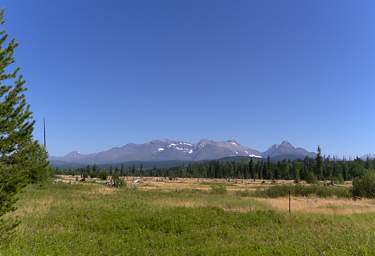 |
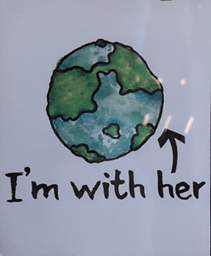 |
| Northern Glacier Park from the Polebridge Mercantile | Yep, I am |
We arrived at the put-in at 13:30, unloaded the rafts, and said good-bye to our vehicles and shuttle drivers.
There were six of us all told — Steve and Diana, me, Reed and Karen, and Pete. Everybody is from Colorado except me. Reed and Karen are retired rafting / fishing guides, and were planning on doing some serious fishing. Pete had his dog Ellie, a Bernese Mountain Dog, along.
Shortly after the shuttle drivers left, Reed discovered he had left all of his flies and other gear back in their travel trailer in the San-Suz-Ed campground. After a bit of a panic, he managed to hitch a ride back to Polebridge, where he got another ride back to the campground. He retrieved his gear and was back in time for dinner.
The rest of us had a leisurely afternoon. After dinner we set up our bear fence, moved all the food inside, and settled in for a good night's sleep. Some of us slept outside; the mosquitos were a bit of a problem but not too bad. I rolled out the silver lining, an ancient 8' x 12' tarp I've carried on trips for years. The weather was so dry there wasn't even any dew in the morning.
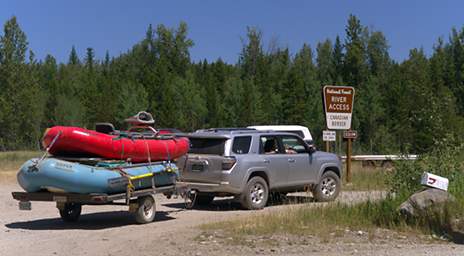 |
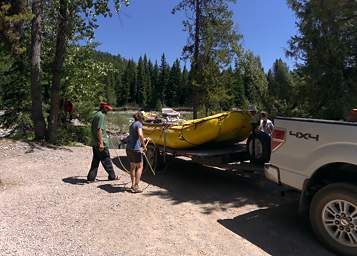 |
| The Canadian Border | Unloading |
Everything you read about the North Fork of the Flathead says it is a wilderness type float, with few people. All of that information is 25 years out of date. Our shuttle drivers told us a few days earlier there was a line of 30 vehicles at the put-in at the Canadian border, where we were, waiting to launch. After we got here at 1:30 in the afternoon, three more parties showed up and launched. On the morning of our launch, a party of nine boats plus one kick-boat drove up and launched before we put on.
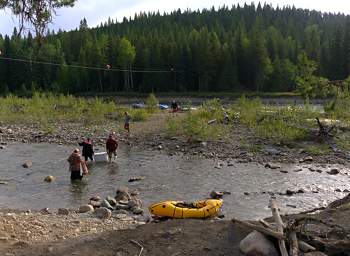 |
| Party of Nine Boats on Launch Day |
The river was dropping, and the side channel near the boat ramp was not flowing enough to float a raft. We modified the channel with some rocks and floated Steve and Diana's raft down to a better spot.
 |
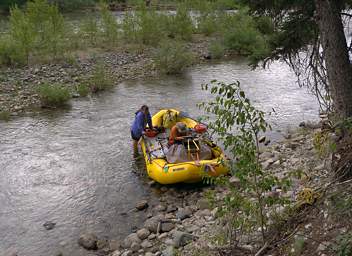 |
| Our Boats in the Side Channel | Loading Up |
Our first day was overcast and cool, much to all of our surprise. I had on a shortie wetsuit and an icebreaker, plus wool socks under my river sandals. I still got a bit chilled with my butt in the water and my feet generally wet. After a bit I donned my rain jacket for additional warmth. I fiddled with the rigging in my boat to see if I could come up with a drier solution, but I still need to work on it. With a bag of gear mounted on the bow and the two sto-floats loaded in the boat, the bow rides about 4" down in the water. There is a "foot brace" or sorts, an inflatable bag that your feet rest on. It's supposed to keep your feet up out of the water, but it doesn't; my heels were constantly imersed.
I didn't fish from the boat; it was just too inconvenient. There's no easy way to store a rod other than shoving the butt down in your life-jacket, and when you hook something you have to figure out what to do with the paddle while you play the fish. There's no easy way to get out and keep hold of the boat, paddle, and your rod while you play the fish from the bank or while standing in the river if you want.
Somewhere in the first few miles we came upon a still-smoking campfire, so I dumped some water on it, stirred it up good, and pulled out the trash. Some people should just stay home.
We had severe restrictions on where we could camp — because Pete had Ellie along, we couldn't camp anywhere on river left, as that's Glacier National Park and no pets are allowed. In addition, the right bank is not all public land, so you need to make sure you are camping on public land. After a short float, about five miles, we found an adequate campsite and pulled in.
One of the features of my new boat is that it has a zipper in the back so you can open up the tubes and stuff gear inside. It comes with two sto-floats, one for each side. They are about the size of a large stuff sack, and have built-in plastic buckles that hold them in place amidships. There's also a loop inside the tube in the back so you could put a third bag there although I didn't utilize that. The zipper is both a cool feature and a pain in the butt. The pain in the butt part is that every night you deflate your boat, so you have to re-inflate it in the morning. However, inflation is pretty simple, and once you get used to it it goes pretty quickly.
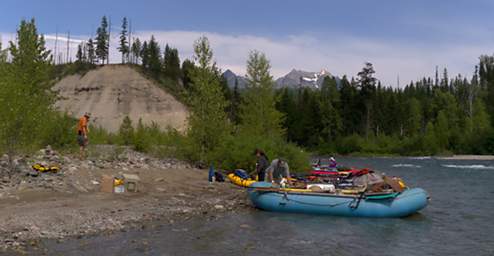 |
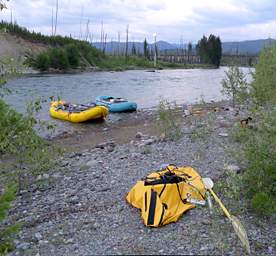 |
| Camp 1 | The North Fork |
I was scheduled to cook dinner the first night. Dinner was Shrimp Pad Thai, and for dessert I adapted my apple-cherry-raisin pie into a cobbler, cooked in the dutch oven. I was a bit worried about it as it didn't seem to be cooking enough, but when the time came it was perfect. Yum!
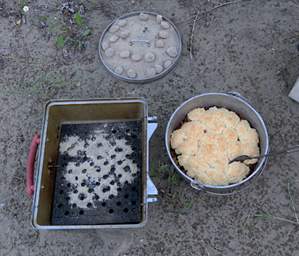 |
| Apple - Cherry - Raisin Cobbler |
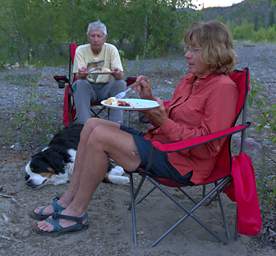 |
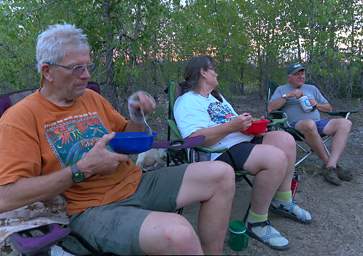 |
| Reed, Ellie and Karen | Steve, Diana and Pete |
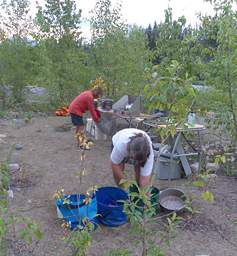 |
| Kitchen Duty |
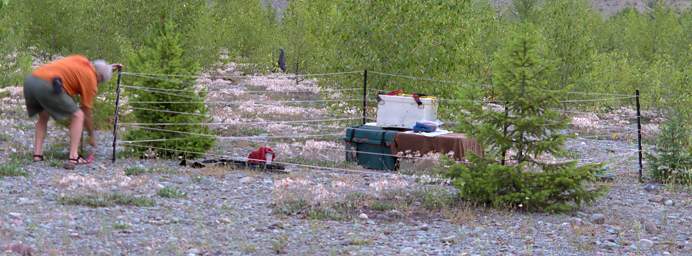 |
| Bear Fence |
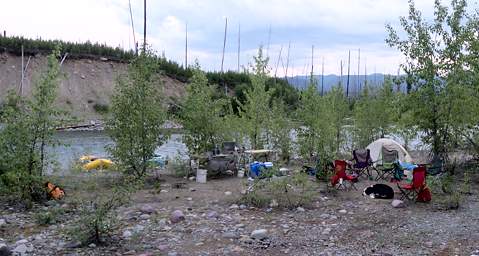 |
| Camp 1 |
The next day dawned clear, warm but not too hot. Pete cooked us pancakes and sausage for breakfast — yum!
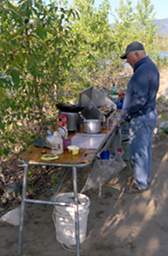 |
 |
| Pete Pancakes | Breakfast |
In the photo below, the big blue Bills Bag is what I had mounted on the bow of my Alpacka Gnarwahl. The little blue bag was my day bag, which I ended up carrying between my legs. The white tube-shaped bag is one of the sto-floats; the rolled up white bag on the silver lining is the other one. I had my tent and a stove and two gas cylinders in one, and my sleeping pad, sleeping bag and the silver lining is the other.
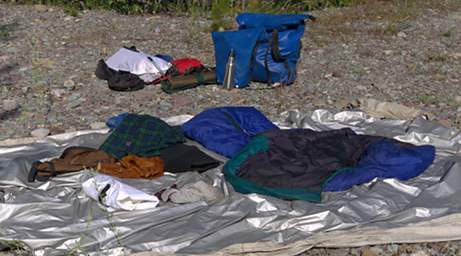 |
| My Camp 1 on the Silver Lining |
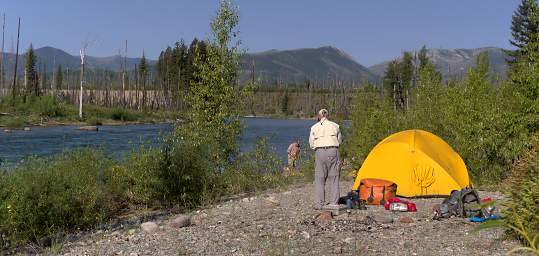 |
| Reed and Karen's Camp 1 |
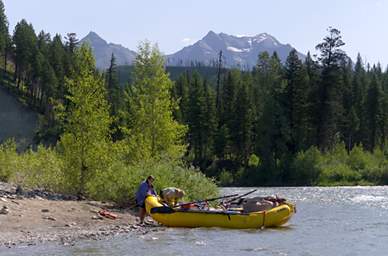 |
| Steve and Diana about ready to Shove Off |
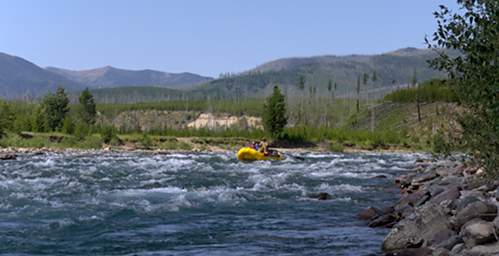 |
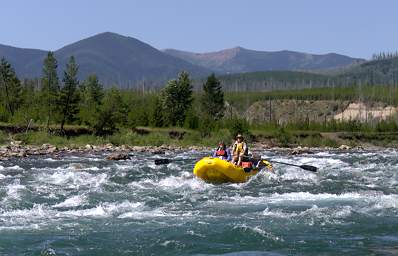 |
| An Actual Rapid | |
 |
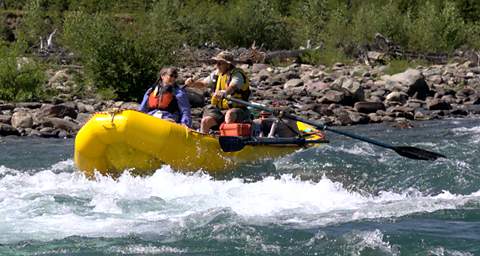 |
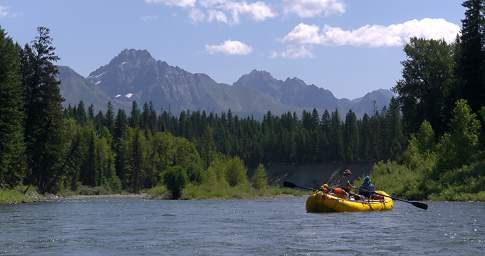 |
 |
| Glacier Park makes a Great Backdrop... | |
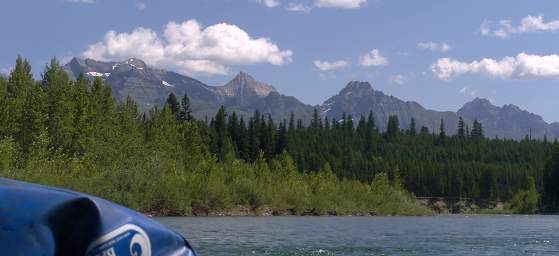 |
We came across several riverside springs, where we could conveniently fill up water bottles without even getting out of the boats.
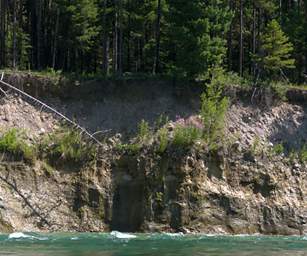 |
| Riverside Spring |
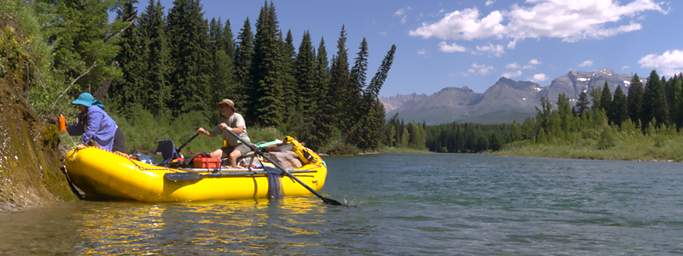 |
| Filling Water |
 |
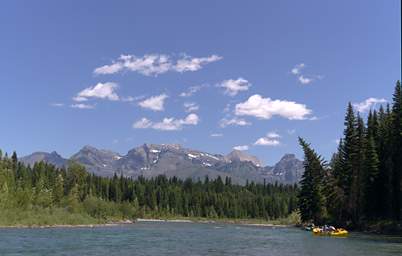 |
| North Fork of the Flathead
Glacier National Park in the Background |
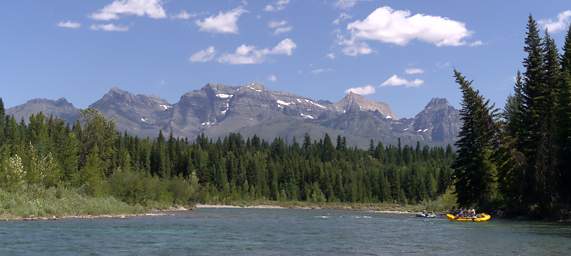 |
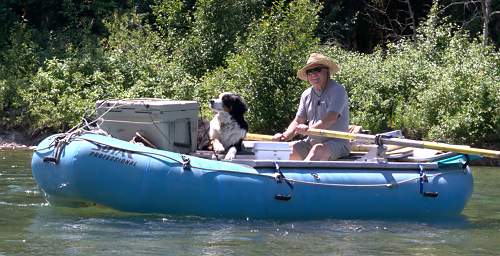 |
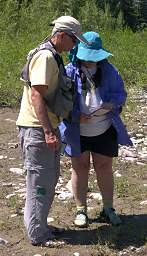 |
| Pete and Ellie | Reed and Diana doing a Map Check |
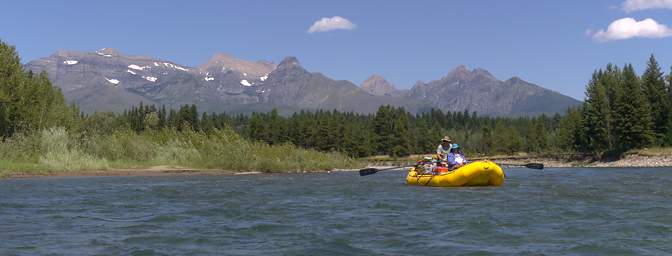 |
We pulled into camp 2 in good spirits. Pete rustled up dinner and we enjoyed the evening alpenglow on the peaks in Glacier National Park.
 |
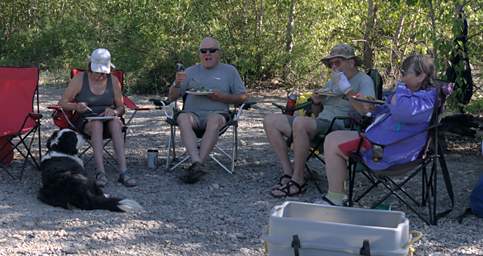 |
| Dinner at Camp 2 | |
 |
| Camp 2 |
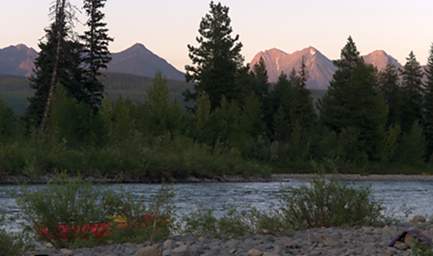 |
| Evening Alpenglow |
I was on for breakfast on day three. I had a simple granola and yogurt planned, but with a treat of cinnamon rolls. I made the dough up after dinner and watched it not rise. I think I got mom's recipe wrong, because it says to mix up the dough and then let it rise overnight in the fridge. That doesn't make sense, as it needs to be warm to ferment. I think you're supposed to let it rise, then store it in the fridge overnight. Anyhoo, I rolled it out, using my arm as a rolling pin. spread cinnamon and sugar liberally all over, sprinkled on a boatload of raisins, rolled it up, cut it into rolls, and filled the dutch oven with them. I stuck them in one of the coolers to rise some more overnight. In the morning I started some charcoal and sat the dutch oven near the charcoal to try and coax them into rising at least a little. When the charcoal was ready, I put nine briquettes on top and six on the bottom; I don't think that was quite enough but it's all I had started so it would have to do. It seemed like they were never going to get done, but when we finally opened them up to eat they were perfect. Wow! A real treat, I was pretty proud. They disappeared in an instant. Yum!
That morning we had a yearling black bear stick his nose into camp, heading straight toward the food cache inside the bear fence. Ellie saw him, emitted a low growl and started over towards him; he about-faced and headed back into the willows from whence he came. So we don't really know how well the bear fence works.
When I got up to start working on breakfast I noticed a Spotted Sandpiper running around noisily trying to distract me. It had a nest in the gravel between our main kitchen area and the bear fence, and there were three eggs and one hatchling in it. We tried to give it a lot of room.
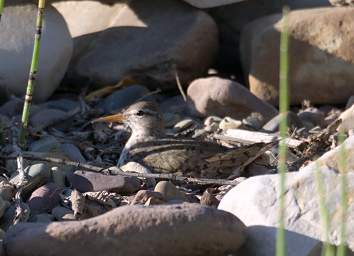 |
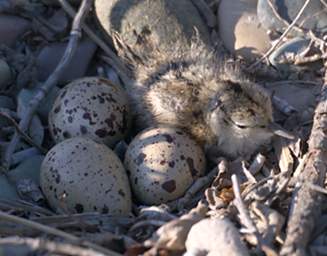 |
| Spotted Sandpiper on Nest | |
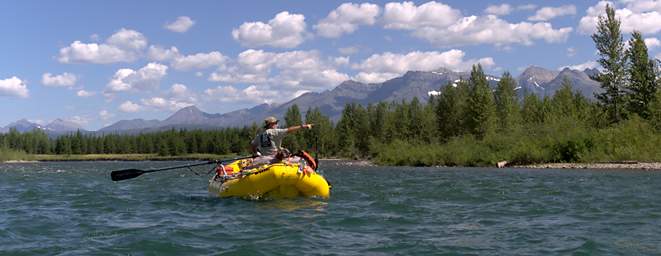 |
We didn't see a lot of wildlife on the river, but we did see some cool things. I saw an otter mucking about in a log jam; Pete saw another one. We saw a white-tailed deer with two fawns, a pretty common sight in these parts. Some really pretty Western Tanagers, a Bald Eagle, and boatloads of Cedar Waxwings.
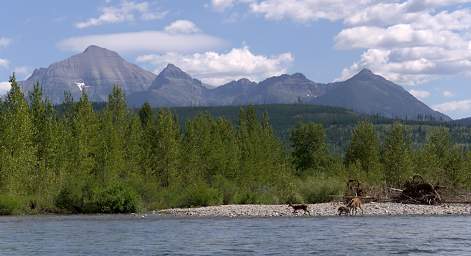 |
| White-Tailed Deer with Fawns |
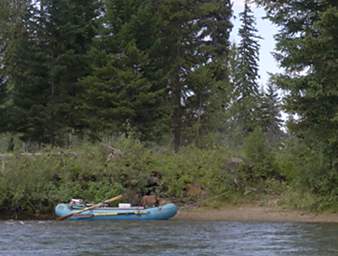 |
| Pete's Boat near Polebridge |
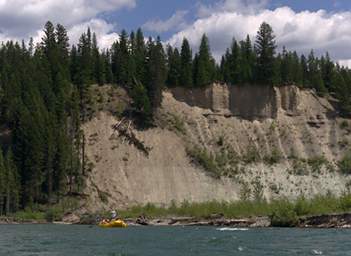 |
 |
| Steep Dirtbanks | Slabs into the River |
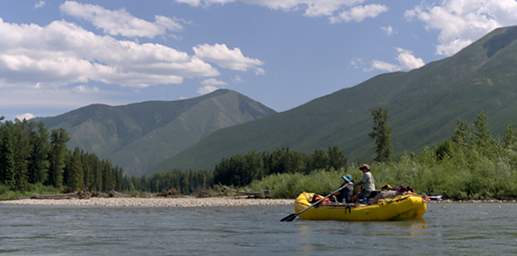 |
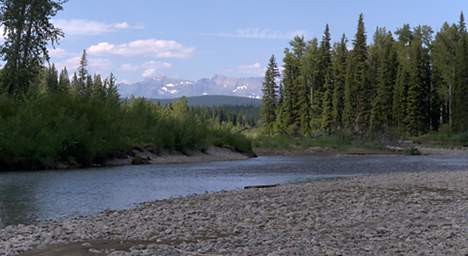 |
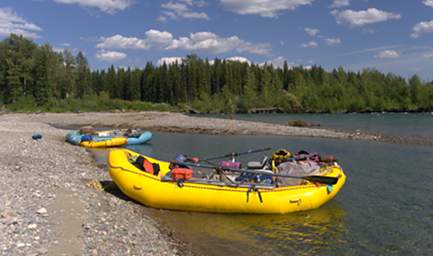 |
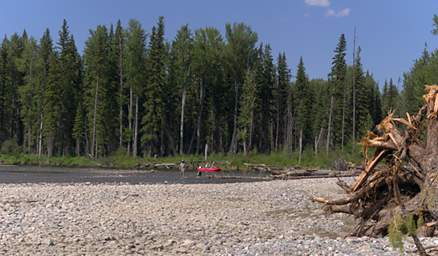 |
| Boats | Island Gravel Bar |
Camp 3 was on the West side of an island. After setting up camp, some of us bushwacked across the island to the other side. We caught a boatload of little fish, Steve found some cool rocks, and we saw the tamest beaver I've ever encountered.
 |
| Camp 3 |
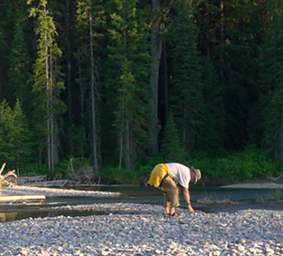 |
| Steve Inspecting Rocks |
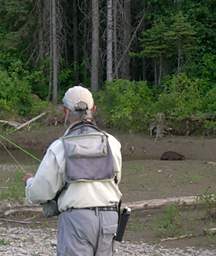 |
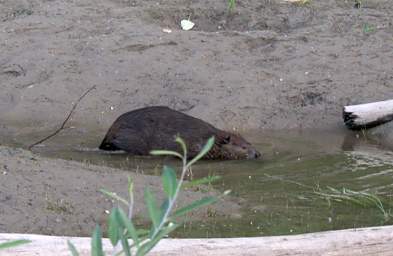 |
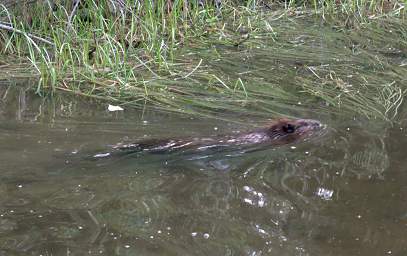 |
| Beaver | ||
We also found some wolf tracks, but no wolves.
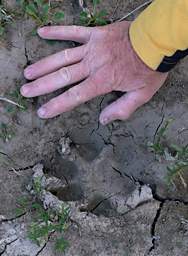 |
| Wolf Track |
In the morning we didn't have any sun. We started a fire to take the chill off, and it felt pretty good.
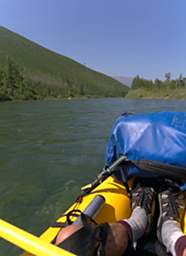 |
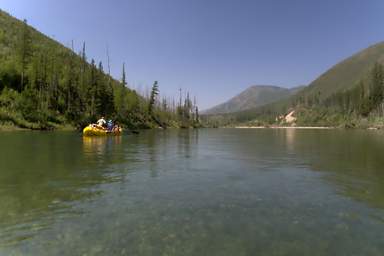 |
 |
| Boats, Lunch Stop at Big Creek |
Our last camp was in the vicinity of Great Northern Flats. Steve set up the groover at a great spot back in the bushes. So great that we had to take a group photo there...
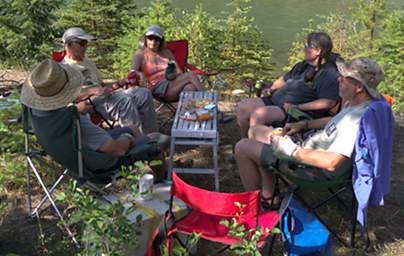 |
| Hors d'Oeuvres |
 |
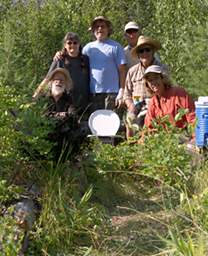 |
| Karen, Reed, Ellie, Gary,
Pete, Diana, Steve |
Group at the Groover
Gary Diana Steve Reed Pete Karen |
Our last day on the river went quickly. The river changes character slightly, moving into more of a canyon like landscape. There are some more significant rapids, and the pools are deeper.
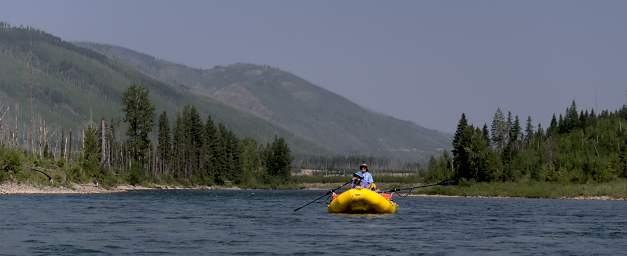 |
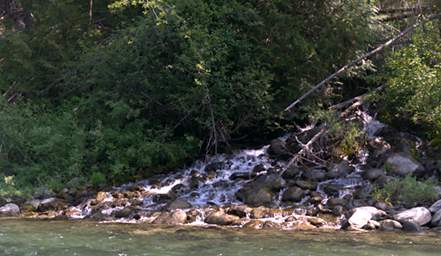 |
| Creek |
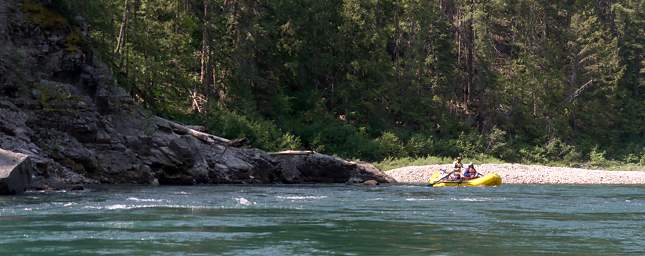 |
| Steve and Diana |
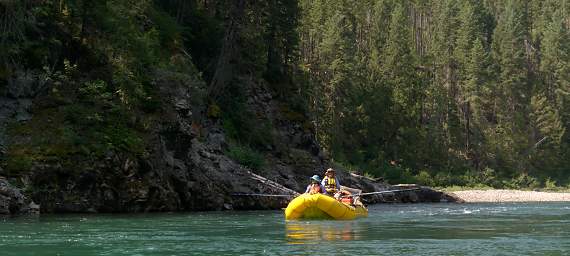 |
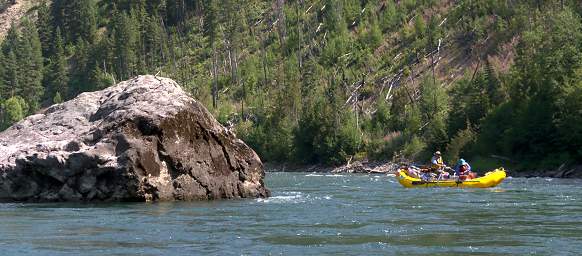 |
 |
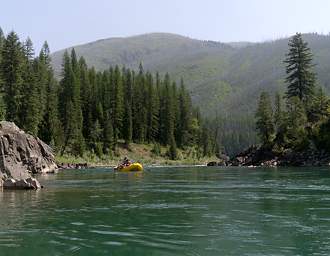 |
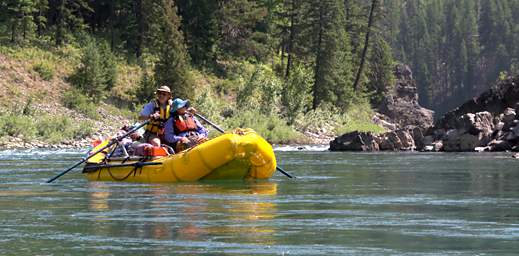 |
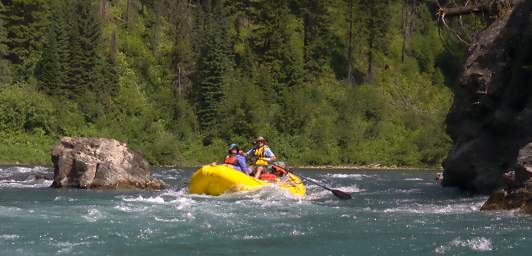 |
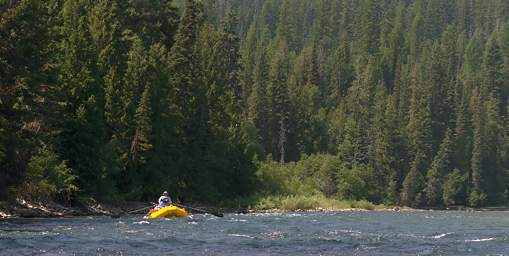 |
All too soon, we were at the take-out at Blankenship bridge.